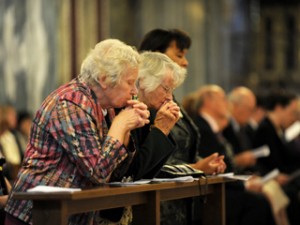 stand, sit, and kneel during Mass?
stand, sit, and kneel during Mass?
If you have ever talked with someone who has seen a Mass for the first time they might tell you that coming to Mass is an odd experience, especially with all the moving going on. Some even might venture to call it “Catholic Calisthenics.” Either way whether you are witnessing for the first time or you regularly come every week the Catholic Mass has lots of movements. The question then becomes, “Why do Catholics stand, sit, and kneel during Mass”?
To begin to answer that question a person must first understand that the Mass is a form of prayer, and certain kinds of prayer require a certain type of posture. Posture in prayer means everything. In our common language one may use the phrase, “actions speak louder than words.” The same is true in prayer. Your posture during prayer speaks to the meaning behind what you’re praying for. So, all of the different postures in Mass are specifically done to convey a specific kind of meaning.
Sitting – referred to “base worship” because it is from this position that we start the Mass, before standing for the opening procession, and it is the posture which mediates between standing and kneeling. The main portion of the Mass that we are sitting for is the Liturgy of the Word. It is during this time that we are to be receptive by listening and focusing on the words being shared to us.
Standing – in the ancient times standing during prayer was a common practice. During the Mass we stand when we are praying together (Collect, Gospel reading, Our Father, and Closing Prayer) as a sign of reverence and community. Some Catholic churches do not have kneelers, in which case standing is the posture that takes place during the Eucharistic prayer.
Kneeling – the most reverent gesture, or most respectful gesture, we can show towards God. We kneel to show our complete surrender and obedience to God, and show we are not equals to God. In Mass we kneel during the Eucharistic Prayer to show our reverence to the bread and wine becoming the Body and Blood of Jesus. Kneeling, especially during the Eucharistic prayer, is a North American practice. Other mentionable times that we kneel are during Adoration, again for the reverence of Jesus being present in the Eucharist. As kneeling is the preferred method individuals who are unable to kneel can still reverently sit or stand during those times.
Beyond the three mentioned above another type of posture mentioned in Catholic circles is prostration. This is done on Good Friday and during ordinations. Prostration is when we lie completely face down on the ground to again show reverence, or deep respect, for God.
Below is the Mass parts in their order and the coordinating posture:
Introductory Rites (All Standing):
Procession
Greeting
Penitential Act
Gloria
Collect
Liturgy of the Word:
First Reading – Sitting
Responsorial Psalm – Sitting
Second Reading – Sitting
Alleluia/Gospel Reading – Standing
Homily – Sitting
Creed – Standing
General Intercessions – Standing
Liturgy of the Eucharist:
Presentation of the Gifts – Sitting
Eucharistic Prayer – Stand then Kneel
Lord’s Prayer/Sign of Peace/Lamb of God – Standing
Communion – Kneel
Concluding Rites (All Standing):
Closing Prayer
Dismissal
Recessional
In conclusion, it can be very easy to look at the Catholic Mass and simply say there is too much moving. However, as with all things Catholic there is a meaning behind everything. More importantly when we connect our beliefs to the actions of the Mass the significance of those actions increases our engagement. Pope Benedict XVI Emeritus said it best, “The man who learns to believe learns also to kneel.” (http://www.adoremus.org/1102TheologyKneel.html) When you are at Mass next time try and think deeply about the posture you are in and connect to what’s happening. You may find yourself more deeply connected with Mass and with our savior Jesus Christ.
For more information please check these websites and videos:
http://www.adoremus.org/1102TheologyKneel.html
